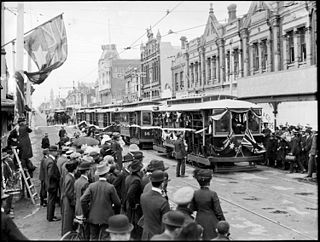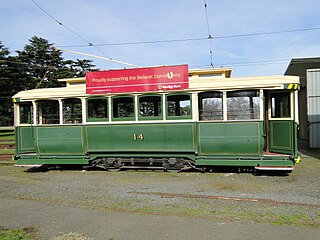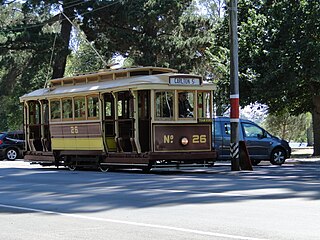The Tramway Museum Society of Victoria Incorporated (TMSV) owns a large collection of trams from Melbourne, Ballarat, Geelong, Adelaide, and Sydney as well as preserved buses and other work vehicles.

The Prahran and Malvern Tramways Trust (PMTT) was a former tram operator in Melbourne, Australia. The trust was formed in 1907, with its first line operating in 1910. Its functions were taken over by the Melbourne & Metropolitan Tramways Board in 1920.

The earliest trams in Australia operated in the latter decades of the 19th century, hauled by horses or "steam tram motors". At the turn of the 20th century, propulsion almost universally turned to electrification, although cable trams lingered in Melbourne. In cities and towns that had trams, they were a major part of public transport assets.

Trams in Ballarat were first used for public transport in 1887. They ceased to operate as a means of public transport in 1971, but a section continues to be operated today as a tourist attraction.

The city of Geelong in Victoria, Australia, operated an extensive tramway system from 1912 until 1956, when the service was replaced by buses. Unlike Victoria's other major regional cities, Ballarat and Bendigo, which have kept some track and trams as tourist attractions, no trams or tracks remain in Geelong.

The Ballarat Tramway Museum is an operating tramway museum, located in Ballarat, Victoria, Australia. The museum is run by volunteers and has a fleet of trams which operate on part of the original horse tramway around Lake Wendouree and the Botanical Gardens. It has a large research collection, archive of information and more than 3,500 items about the Ballarat tramways. The trams in Ballarat operated on a large network through the city from 1887 until 1971.
The A-class was a class of 20 trams built by Duncan & Fraser, Adelaide for the Prahran & Malvern Tramways Trust (PMTT). All passed to the Melbourne & Metropolitan Tramways Board on 2 February 1920 when it took over the PMTT becoming the A-class retaining their running numbers.

The C-class was a group of 11 trams built by Duncan & Fraser, Adelaide for the Prahran & Malvern Tramways Trust (P&MTT) in 1913, numbered 25 to 35. All retained their fleet numbers when passed to the Melbourne & Metropolitan Tramways Board (M&MTB) on 2 February 1920, after it took over the P&MTT. They were designated C-class sometime after October 1921, and by late 1923, all M&MTB drop-end-and-centre Maximum Traction trams were grouped together as C-class trams. The 22E Maximum Traction trucks were of JG Brill design, although manufactured by Brush in England.
Prahran & Malvern Tramways Trust (P&MTT) tram No.36 was one of a batch of ten Maximum Traction bogie cars built in 1914 by Duncan & Fraser, Adelaide. Although the lowest numbered of this group, it was the last to enter service, and was the first P&MTT tram to be equipped with 2 x 65 hp (48 kW) GE 201G motors. Subsequently, all other P&MTT Maximum Traction bogie cars were later retro-fitted with the same type of motors. The 22E Maximum Traction trucks were of JG Brill design, although manufactured by Brush in England.

The E-class was a group of 10 trams built by Duncan & Fraser, Adelaide, for the Prahran & Malvern Tramways Trust (P&MTT) in 1914, numbered 36 to 45. Number 36 was converted to a different form by the P&MTT c. 1916, and was later designated D-class. All retained their fleet numbers when passed to the Melbourne & Metropolitan Tramways Board (M&MTB) after it took over the P&MTT on 2 February 1920, and they were designated E-class sometime after October 1921. By late 1923, together with other all M&MTB drop-end-and-centre Maximum Traction trams, they were re-classed as C-class trams. The 22E Maximum Traction trucks were of JG Brill design, although manufactured by Brush in England.
The F-class was a class of two trams built by Duncan & Fraser, Adelaide, for the Prahran & Malvern Tramways Trust (PMTT). Both passed to the Melbourne & Metropolitan Tramways Board on 2 February 1920 when it took over the PMTT, becoming the F-class and retaining their running numbers. They were designed as summer cars, with five doors on each side. When rebuilt in 1923, some of the doors were filled in and longitudinal seating was fitted.
The G-class was a class of six trams built by Duncan & Fraser, Adelaide, for the Prahran & Malvern Tramways Trust (PMTT). All passed to the Melbourne & Metropolitan Tramways Board on 2 February 1920 when it took over the PMTT, becoming the G-class and retaining their running numbers. They were similar to the F-class but had arched rather than clerestory roofs.

The J-class was a class of twenty trams built by the Meadowbank Manufacturing Company, Sydney for the Prahran & Malvern Tramways Trust (PMTT). All passed to the Melbourne & Metropolitan Tramways Board on 2 February 1920 when it took over the PMTT becoming the J-class retaining their running numbers.
The K-class was a class of nine trams built by James Moore & Sons for the Prahran & Malvern Tramways Trust (PMTT). All passed to the Melbourne & Metropolitan Tramways Board on 2 February 1920 when it took over the PMTT becoming the K-class retaining their running numbers.
The L-class was a class of six trams ordered from James Moore & Sons by the Prahran & Malvern Tramways Trust (PMTT). However, by the time they were delivered in 1921, the PMTT had been taken over by the Melbourne & Metropolitan Tramways Board (MMTB).

The M-class was a class of 17 trams built by Duncan & Fraser, Adelaide for the Hawthorn Tramways Trust (HTT) as numbers 1 to 10, and 33 to 39. All passed to the Melbourne & Metropolitan Tramways Board on 2 February 1920 when it took over the Municipal Tramway Trusts, becoming the M-class and being renumbered 107 to 116, and 183 to 189.
The N-class was a class of 10 trams built by Duncan & Fraser, Adelaide for the Hawthorn Tramways Trust (HTT) as numbers 11 to 20, all passed to the Melbourne & Metropolitan Tramways Board (M&MTB) on 2 February 1920 when it took over the HTT, becoming the N-class and being renumbered 117 to 126.

The P-class was a class of eight trams built by Duncan & Fraser, Adelaide for the Hawthorn Tramway Trust (HTT) as numbers 25 to 32. All passed to the Melbourne & Metropolitan Tramways Board on 2 February 1920 when it took over the HTT becoming the P-class and being renumbered 131 to 138.
The Melbourne tram network began in 1884 with the construction of the Fairfield Horse Tramway. However, the purpose of the line was to increase land prices in the area, and it soon closed during the depression in 1890. The first genuine attempt to construct a tramway network was the construction of the Richmond cable tram line by the Melbourne Tramway & Omnibus Company in 1885. Over the next few years, 16 more cable tram lines were constructed, as well as numerous other horse tramways. The depression of the early 1890s slowed further expansion of the cable network. The first electric tram line was the Box Hill and Doncaster tramway which opened in 1889. This was a pioneering line in what was then the countryside and thus didn't receive much patronage. It closed in 1896. The next attempt at an electric tramway was Victorian Railways' St Kilda to Brighton line, which opened in 1906. Later that year, the North Melbourne Electric Tramway & Lighting Company opened lines to Essendon and Maribyrnong. Many local councils formed their own tramway trusts and built tramways within their own constituency. The most successful of these was the Prahran & Malvern Tramways Trust.
The Melbourne Tramcar Preservation Association is a tram preservation society in Haddon, Victoria, Australia.










